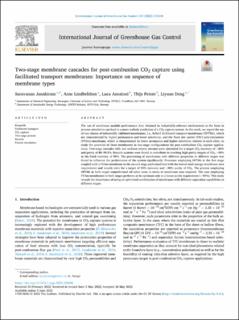| dc.contributor.author | Janakiram, Saravanan | |
| dc.contributor.author | Lindbråthen, Arne | |
| dc.contributor.author | Ansaloni, Luca | |
| dc.contributor.author | Peters, Thijs | |
| dc.contributor.author | Deng, Liyuan | |
| dc.date.accessioned | 2023-02-17T07:56:48Z | |
| dc.date.available | 2023-02-17T07:56:48Z | |
| dc.date.created | 2022-08-22T12:54:31Z | |
| dc.date.issued | 2022 | |
| dc.identifier.citation | International Journal of Greenhouse Gas Control. 2022, 119 1-10. | en_US |
| dc.identifier.issn | 1750-5836 | |
| dc.identifier.uri | https://hdl.handle.net/11250/3051769 | |
| dc.description.abstract | The use of membrane module performance data obtained in industrially-relevant environment as the basis in process simulation can lead to a more realistic prediction of a CO2 capture system. In this work, we report the use of two classes of industrially validated membranes, i.e., hybrid facilitated transport membranes (HFTMs), which are characterized by higher permeances and lower selectivity, and the fixed site carrier (FSC) polyvinylamine (PVAm) membrane, which is characterized by lower permeance and higher selectivity relative to each other, to study the potential of these membranes in two-stage configurations for post-combustion CO2 capture applications. Two-stage cascades with and without recycle streams were simulated for a target CO2 recovery of >80% and purity of 80–99.5%. Recycle systems were found to contribute in reaching high purity targets of CO2 >90% at the fixed recovery of 90%. The positioning of membranes with different properties in different stages was found to influence the performance of the system significantly. Processes employing HFTMs in the first stage coupled with a PVAm membrane in the second stage performed best with the lowest total energy/membrane area requirement and recycle ratio for a target of 90% recovery and >90% purity of CO2. The process employing HFTMs in both stages outperformed all other cases in terms of membrane area required. The case employing PVAm membranes in both stages performs at its optimum only at a lower purity requirement (<90%). This study reveals the importance of using an optimized combination of membranes with different separation capabilities at different stages. | en_US |
| dc.language.iso | eng | en_US |
| dc.publisher | Elsevier | en_US |
| dc.rights | Navngivelse 4.0 Internasjonal | * |
| dc.rights.uri | http://creativecommons.org/licenses/by/4.0/deed.no | * |
| dc.subject | Process simulation | en_US |
| dc.subject | Recycle | en_US |
| dc.subject | Two-stage process | en_US |
| dc.subject | CO2 capture | en_US |
| dc.subject | Facilitated transport | en_US |
| dc.title | Two-stage membrane cascades for post-combustion CO2 capture using facilitated transport membranes: Importance on sequence of membrane types | en_US |
| dc.type | Peer reviewed | en_US |
| dc.type | Journal article | en_US |
| dc.description.version | publishedVersion | en_US |
| dc.rights.holder | © 2022 The Authors. Published by Elsevier Ltd. | en_US |
| dc.source.pagenumber | 1-10 | en_US |
| dc.source.volume | 119 | en_US |
| dc.source.journal | International Journal of Greenhouse Gas Control | en_US |
| dc.identifier.doi | 10.1016/j.ijggc.2022.103698 | |
| dc.identifier.cristin | 2044944 | |
| dc.relation.project | Norges forskningsråd: 294533 | en_US |
| dc.source.articlenumber | 103698 | en_US |
| cristin.ispublished | true | |
| cristin.fulltext | original | |
| cristin.qualitycode | 1 | |

